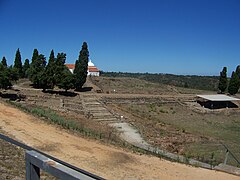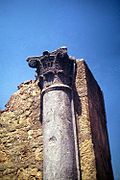
The Castle of Salir is an Almohad fortress, located in the civil parish of the same name, 16 kilometres from the municipality seat of Loulé in the Portuguese Algarve.

Alandroal is a municipality in the Portuguese district of Évora located on the eastern frontier with Spain along the right margin of the Guadiana River in the Central Alentejo region. It is located 341 metres (1,119 ft) above sea level, northeast of Évora and southeast of Estremoz. The population in 2011 was 5,843, in an area of 542.68 km².

Santiago do Cacém is a municipality in Setúbal District in Portugal. The population in 2011 was 29,749, in an area of 1059.69 km2.
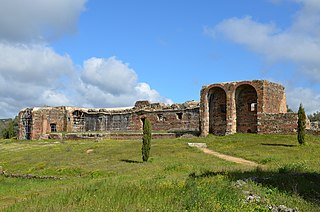
The Roman ruins of São Cucufate is a Romanesque archaeological site, located on the ruins of a Roman-era agricultural farm in the civil parish of Vila de Frades, in the municipality of Vidigueira, in the southern Alentejo, Portugal. The convent, which dates back to Middle Ages, was dedicated to the martyred saint Cucuphas.

The Roman ruins of Villa Cardillio is an archaeological site located in central Portugal. Situated in the rural civil parish of Santa Maria, it is located approximately 3 km from the centre of the municipal seat of Torres Novas. Receiving its name from a mosaic pavement onsite, the specific translation of piece is still unclear, but assumed that the site was owned by a couple. The ruins were first excavated in 1962, yielding hundreds of coins and well as ceramics, bronze works, Assyrian and Egyptian glass works. Also revealed were some jewellery and a statue of Eros.
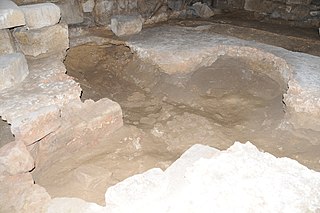
The Monastery of Dumio, is a former paleo-Christian monastery in the civil parish of Dume, municipality of Braga, in northwestern Portugal. Originally a Roman villa, it was the base of a basilica by Suebi tribes, and later Christian monastery headed by Martin of Braga in the 6th century. The re-discovery of the Roman ruins in the late 20th century resulted in archaeological excavations that unearthed its former use.

The Castle of Paderne is an ancient fortification located in the civil parish of Paderne, municipality of Albufeira, in the Portuguese Algarve. It was constructed in the later 12th century by Berbers, in an area around 7.5 kilometres (4.7 mi) inland.

The Fort of Nossa Senhora da Rocha is a medieval castle situated in the civil parish of Porches, in the municipality of Lagoa in Portuguese Algarve. Inside the fort is the Chapel of Nossa Senhora da Rocha, of uncertain date.
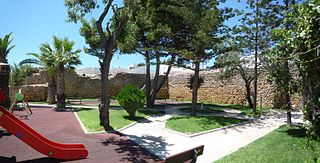
The Castle of Alvor is a medieval castle in the civil parish of Alvor, in the Portuguese district of Faro: considered to be a significant military monument associated with the nearby Castle of Silves.

The Roman Ruins of Cerro da Vila are the remnants of a historical villa in the Algarve region of southern Portugal. Its vestiges lie in the vicinity of the resort and marina of Vilamoura, in the civil parish of Quarteira, municipality of Loulé Municipality.

The Roman ruins of Ammaia are located in Portugal within the Nature Park of the Serra de São Mamede, a mountainous expanse of forest in the civil parish of São Salvador da Aramenha, municipality of Marvão, along the border with Spain.

The Castle of Faria is a castle in the northern Portuguese civil parish of Gilmonde, municipality of Barcelos, in the Cávado.

The Castle of Freixo de Numão, is a Portuguese medieval castle in civil parish of Freixo de Numão, in the municipality of Vila Nova de Foz Côa, in the district of Guarda.

The Roman ruins of Casais Velhos are the remains of a Roman town, in the municipality of Cascais, Lisbon District, Portugal that included baths, two cemeteries, remains of a wall and ceramic artifacts.

The Roman Thermae of Maximinus, are the archaeological ruins of a monumental building and public baths, whose construction was integrated into the urban renewal of the civitas of Bracara Augusta, the Roman provincial capital of Gallaecia. The large public/civic construction consisted of a building, housing the baths and a theatre, although the archaeological excavations continue.

The Former Cathedral of Idanha-a-Velha is the decommissioned medieval Catholic cathedral of the former bishopric of Egitânia, in the Freguesia of Monsanto e Idanha-a-Velha, in the municipality of Idanha-a-Nova, in the central Portuguese district of Castelo Branco.
The Castro of Castelo Velho is a Chalcolithic settlement in the civil parish of Terena, municipality of Alandroal in the Alentejo Central area of the Portuguese Alentejo.
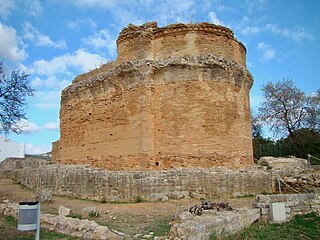
The Roman ruins of Milreu are the remains of an important Roman villa rustica located in the civil parish of Estói in the municipality of Faro, Portugal, classified as a Monumento Nacional. The Milreu ruins constitute the most prominent and well preserved evidence of Roman presence in the Algarve. They are mainly composed of the remnants of a once luxurious villa with annexed thermae and several surrounding buildings, including a temple, mausoleum and industrial and commercial structures. The archaeological site still preserves part of the once exuberant mosaics that decorated the floor and walls of the villa. A 16th century house is also located in the area, alongside an interpretation centre.
A castro is a fortified settlement, usually pre-Roman, associated with the Celtic culture. These are frequently found in Portugal, usually in the North, but can also be found elsewhere. The word castro comes from the Latin castrum, which means "hill fort".


![]() was an ancient town in the westernmost part of Lusitania during the Iron Age and Roman Times that was mentioned by Pliny the Elder and Ptolemy.
was an ancient town in the westernmost part of Lusitania during the Iron Age and Roman Times that was mentioned by Pliny the Elder and Ptolemy.




